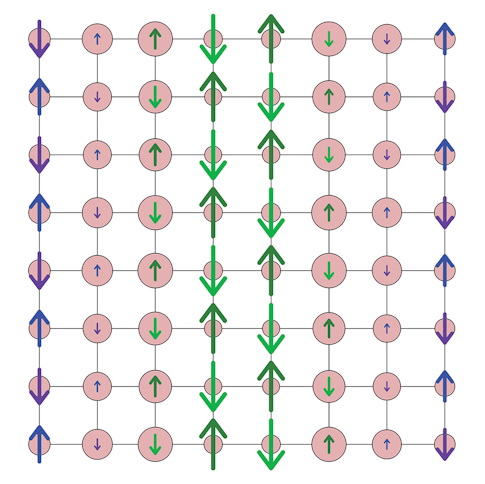
Many’s Not Too Many Anymore for Quantum Systems
 Physicists first learn their trade by studying simple systems: a pendulum swinging under gravity or an electron in thrall to a proton, forming a lone hydrogen atom. The equations that describe these systems can be solved with pencil and paper, and more elaborate calculations have provided some of the most precise and accurate predictions in all of science. Yet this approach can rapidly fall apart for more complicated systems, especially when the components are strongly coupled and must be described using the laws of quantum mechanics. The combination of coupling and quantum mechanics causes their behavior to become correlated in unfathomable ways. But in many solid materials vital for technology — think semiconductors and high-temperature superconductors — the physics involves a vast number of strongly correlated electrons.
Physicists first learn their trade by studying simple systems: a pendulum swinging under gravity or an electron in thrall to a proton, forming a lone hydrogen atom. The equations that describe these systems can be solved with pencil and paper, and more elaborate calculations have provided some of the most precise and accurate predictions in all of science. Yet this approach can rapidly fall apart for more complicated systems, especially when the components are strongly coupled and must be described using the laws of quantum mechanics. The combination of coupling and quantum mechanics causes their behavior to become correlated in unfathomable ways. But in many solid materials vital for technology — think semiconductors and high-temperature superconductors — the physics involves a vast number of strongly correlated electrons.
A quarter-century ago, the problem of understanding a system of many correlated electrons seemed intractable. Even under the onslaught of the most powerful computers, only a few specific cases could be solved.
Today, this picture has changed. Steady progress in computer hardware and software in the past 25 years has helped, but ‘Moore’s law’ is no match on its own for the barriers posed by the quantum states of a throng of electrons. More important are new insights into the problem itself. According to Andy Millis, co-director of the Simons Collaboration on the Many Electron Problem and the Flatiron Institute’s Center for Computational Quantum Physics (CCQ), if there is one overarching insight driving recent progress, it is the more sophisticated understanding researchers have achieved about a uniquely quantum-mechanical phenomenon called entanglement.
When particles are entangled, their states become weirdly linked in a way that has no exact analogue in the classical physics that describes our everyday reality. In the field of quantum computing, researchers are striving to design and build devices that exploit entanglement’s remarkable properties as a resource and enable new types of computation. For theorists working on the many-electron problem, however, entanglement represents a barrier to be overcome. The powerful insight they’ve gained, Millis explains, “is that entanglement is physical, and you should pay attention to it.”

In particular, entanglement has some unexpected quirks in the ground state of a many-electron system, that is, the overall quantum state that the collection of electrons will settle into. The nature of that state determines the material’s fundamental properties — for instance, is it an insulator or a superconductor, or something even stranger? Mapping out how the ground state varies under changes to the material’s structure or composition, or other conditions such as its temperature, is essential for both abstract understanding and practical technological goals. The quest to determine the ground state is essentially a search through the space of all possible quantum states of the system. But as the system is made larger, one electron at a time, the size of the search space grows exponentially. ‘Needle in a haystack’ doesn’t come close to conveying the magnitude of the problem.
Almost all of the plethora of possible quantum states have large amounts of entanglement connecting electrons across the whole system. But scientists have come to understand that the ground states of many systems of interest typically have a special characteristic: An electron may be entangled with relatively nearby electrons, but it will have little entanglement with the more distant ones. The states with this ‘localized’ form of entanglement constitute a comparatively tiny subspace of all the entangled states. The search for the ground state becomes more manageable if it can somehow be limited to this subspace.
The localized entanglement is also expressed as recently discovered ‘area laws’ obeyed by the ground states in many systems of interest: If we imagine isolating a small piece of the system and measuring how entangled it is with the rest of the system, we find, surprisingly, that the entanglement is proportional to the surface area of the piece, not its volume. (This result is intriguingly similar to the area law for the entropy of a black hole and to deep theoretical speculations in particle physics called the holographic principle.)
This insight is now being exploited in methods employed by several broad research teams that make up the many-electron collaboration and CCQ. One example is the use of tensor networks: descriptions of quantum systems as collections of building blocks (the tensors) connected by wires. Tensor networks have been around for decades, but researchers have only recently gained a deeper understanding of their connection with entanglement. These networks compactly represent the properties of quantum states with localized entanglement. In the best cases, they make numerical computations practical.
A different approach focuses more directly on isolating a very small subsystem. This ‘quantum embedding’ technique involves performing detailed, full calculations for the subsystem with the remainder of the system serving as an environment whose effects are approximated in these calculations. The subsystem might be as small as a single electron orbital on a particular copper atom in a superconductor. Antoine Georges, the director of CCQ and the collaboration, invented one of the most important methods along these lines.
The method works best when the entanglement and correlations are very spatially localized; an important ongoing area of research revolves around increasing the size of the cluster so as to treat systems with longer-range entanglement and correlations.

Another fascinating possibility is to use artificial neural networks. The problem of the huge space of highly entangled states containing a much smaller space of interest, with locally entangled states, is analogous to the problems that neural networks have proved very adept at solving in recent years, such as recognizing speech or thoroughly defeating the world champion at the game of Go. For the many-electron problem, a neural network could find and operate in the low-dimensional subspace of interest for a given system in an automated fashion. This approach was demonstrated in 2017 for one particular many-body problem by Giuseppe Carleo and Matthias Troyer of ETH Zurich (Carleo has subsequently joined CCQ). A surge of intense interest and additional work by many researchers has followed.
This automated approach “is the great thing that neural networks do for you,” Millis explains. “In many cases, science got stuck because physical intuition or pure thought was not enough and didn’t allow you to construct the low-dimensional subspace you really needed to work with. The methods of Carleo and Troyer let us construct the space of relevant states in an unbiased way.”
Besides learning to handle entanglement and implementing new computational methods, the many-body scientists have also embraced the philosophy that solving the many electron problem demands a modern infrastructure — namely, the development of modular open-source software libraries for each technique. This infrastructure will allow researchers and graduate students not only to get quickly up to speed on performing actual computations on model systems, but also to put together the software codes and structures, Millis says, “in new and creative ways, to do things we hadn’t even quite imagined.” With the emerging new tools and approaches, physicists have become optimistic about finally getting the science of many bodies unstuck.
